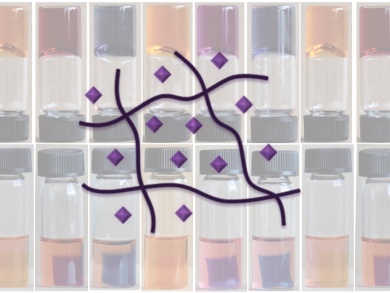Gels That Respond to Their Environment
For many years, chemists have honed their skills in creating responsive gels that swell and contract depending on the environment in which they find themselves. Such materials have applications in sensors, in actuators for microelectromechanical systems (MEMS), in tissue engineering and in drug delivery capsules that open up to deliver their payload to a disease site, as well as other biomaterials uses.
Supramolecular hydrogels formed by the addition of a low molecular mass gelating agent to an aqueous solution have been considered as having greater thermal and stimuli responsiveness than their polymer counterparts. They also have a tendency towards greater biocompatibility because the gelators can be made from amino acids, sugars and steroid molecules rather than synthetic polymers used in many hydrogel formulations.
However, Long Qin, Fan Xie, Pengfei Duan, and Minghua Liu of the Beijing National Laboratory for Molecular Science at the Chinese Academy of Sciences point out in Chemistry – A European Journal that supramolecular gels have a drawback. Because the non-covalent interactions that hold them together are inherently weak they produce only fragile three-dimensional structures that cannot fold and curl in as robust a manner as polymer hydrogels. This limits their ability to shrink and swell in a volume-changing phase transition which in turn limits their potential as biomaterials.
Selective Shrinkage Based on pH or the Presence of Charged Species
The team has now used divalent metal ions to create a shrinkable supramolecular metallo-hydrogel based on a peptide dendron formed from the amino acid L-glutamic acid, namely N-octadecanoyl-1,5-bis(L-glutamic acid)-L-glutamic diamide (OGAc), and magnesium ions. They have demonstrated a reversible volume-phase transition dependent on pH. The team also demonstrated that their hydrogel would show selective shrinkage if positive ions were added to the system, although it would remain as an expanded gel in the presence of negative ions.
Their experiments and transmission electron microscopy results suggest that the pH responsiveness of their supramolecular hydrogel not only hinges on the presence of the four carboxylic acid groups present in OGAc but in the way in which micelles form or not and then become entangled. Under strongly acidic conditions those carboxylic groups cannot be ionized and so the gelator becomes still more hydrophobic, which leads to the formation of worm-like micelles that readily become entangled and locked together through hydrogen bonds, stiffening the material.
Separating Dyes and Releasing Drugs
The researchers suggest that this blend of properties – pH and positive/negative ion response selectivity – might allow it to be used as a vehicle for separating mixtures of ionic dyes. The cationic species were incorporated predominantly into the shrunken gel, while negatively charged dye molecules were released into aqueous solution, the team reports. Of course, if it can carry and discriminate between dye molecules the same gel might be used to carry two distinct pharmaceutical molecules, releasing them into a target site in the body in two steps. A drug with a negative charge would be released first and a second component could be released upon a pH change, a variable which is commonly different in healthy tissues or fluids and diseased or malignant regions of the body.
The team concedes that the system is actually not particularly sophisticated, it is nevertheless a proof of principle and represents the first example of a responsive, shrinkable supramolecular hydrogel that might be used to deliver multicomponent therapeutic agents in two steps. “We are trying to control the release of the two drugs stepwise using light or a combination of light and metal ions,” Liu told ChemViews Magazine.
- A Peptide Dendron-Based Shrinkable Metallo-hydrogel for Charged Species Separation and Stepwise Release of Drugs,
Long Qin, Fan Xie, Pengfei Duan, Minghua Liu,
Chem. Eur. J. 2014.
DOI: 10.1002/chem.201404035




